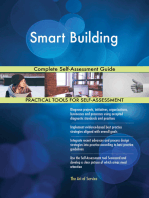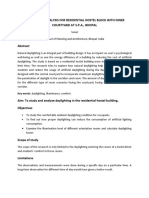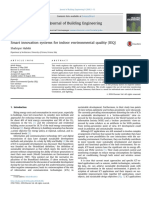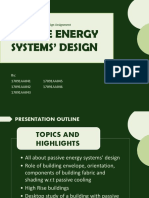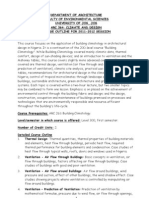Importance of Daylight
Importance of Daylight
Uploaded by
Pedro VítorCopyright:
Available Formats
Importance of Daylight
Importance of Daylight
Uploaded by
Pedro VítorOriginal Description:
Original Title
Copyright
Available Formats
Share this document
Did you find this document useful?
Is this content inappropriate?
Copyright:
Available Formats
Importance of Daylight
Importance of Daylight
Uploaded by
Pedro VítorCopyright:
Available Formats
introduction
1-1
In a world newly concerned about carbon emissions, global warming, and sustainable
design, the planned use of natural light in non-residential buildings has become an
important strategy to improve energy efficiency by minimizing lighting, heating, and
cooling loads. The introduction of innovative, advanced daylighting strategies and systems
can considerably reduce a buildings electricity consumption and also significantly improve
the quality of light in an indoor environment.
Evidence that daylight is desirable can be found in research as well as in observations of
human behaviour and the arrangement of office space. Windows that admit daylight in
buildings are important for the view and connection they provide with the outdoors.
Daylight is also important for its quality, spectral composition, and variability. A review
of peoples reactions to indoor environments suggests that daylight is desired because it
fulfils two very basic human requirements: to be able to see both a task and the space well,
and to experience some environmental stimulation [Boyce 1998]. Working long-term in
electric lighting is believed to be deleterious to health; working by daylight is believed to
result in less stress and discomfort.
Daylight provides high illuminance and permits excellent colour discrimination and colour
rendering. These two properties mean that daylight provides the condition for good
vision. However, daylight can also produce uncomfortable solar glare and very high-
luminance reflections on display screens, both of which interfere with good vision. Thus,
the effect of daylight on the performance of tasks depends on how the daylight is
delivered. All of these factors need to be considered in daylighting design for buildings.
Introduction 1.
Importance of Daylight 1.1.
1-2 daylight in buildings
Daylight strategies and systems have not always lived up to their promise as energy-
efficiency strategies that enhance occupant comfort and performance. One reason is the
lack of appropriate, low-cost, high-performance daylighting systems, simple tools to
predict the performance of these advanced daylight strategies, and techniques to integrate
daylight planning into the building design process.
Common barriers that have hindered the integration of daylight in buildings in the
past are:
Lack of knowledge regarding the performance of advanced daylighting systems
and lighting control strategies,
Lack of appropriate, user-friendly daylighting design tools, and
Lack of evidence of the advantages of daylighting in buildings.
The barriers, identified at the beginning of the International Energy Agency (IEA) Solar
Heating and Cooling (SHC) Task 21: Daylighting of Buildings, were resolved by
coordinated tasks that covered three broad areas: 1) assessment of the performance of
systems and lighting control strategies, 2) development of integrated design tools, and
3) case studies to provide evidence of daylight performance in actual buildings.
To remedy the lack of information about the performance of advanced daylighting systems,
specified systems were assessed using standard monitoring procedures in test rooms in
actual buildings, and using scale models under artificial skies. Parameters to measure both
quantity (e.g., illuminance and luminance) and quality (e.g., visual comfort and
acceptability) of daylight were determined prior to testing. This source book describes the
systems tested, the results of the assessments, and the appropriate application of the results.
On the whole, the studys results indicate that, when appropriately located, the majority
of systems tested improved daylighting performance in perimeter building zones relative
to the performance of conventional windows.
The daylighting of buildings is essentially a systems integration challenge for a
multidisciplinary design team, involving building siting and orientation and the design
optimization of fenestration, lighting and control systems. A survey of existing architectural
solutions is included in this source book as a CD-ROM, which shows the integration of
systems in building design and includes conventional as well as advanced systems with
some indication of the problems that may result from wrong design decisions.
This source book is aimed at building design practitioners, lighting engineers, and product
manufacturers. It should be used in the earliest stages of the design process because the
initial conception of the building envelope, the location of openings and their size and
shape, and the systems for solar and daylighting control are all crucial to daylighting design.
introduction 1-3
The objective of this source book is to promote daylighting-conscious building design.
Selected advanced daylighting systems are described in detail, as well as ways in which
these daylighting systems can be integrated in the overall building design process. The
reader is also introduced to shading and electric lighting control systems and design tools.
Daylighting planning needs to be considered from a buildings conceptual design phase
through the selection of systems and their application. Chapter 2 outlines initial-stage
planning parameters, such as basic decisions on shape and window size, as well as
specific functional objectives of the daylighting strategies. Application of daylight strategies
for windows and rooms is also discussed, along with advice on how to choose systems
for specific sky types.
Innovative daylighting systems work by redirecting incoming sunlight and/or skylight to
areas where it is required, and, at the same time, controlling glare. These systems are
particularly appropriate where an interior space is too deep for conventional windows to
provide adequately uniform lighting or where there are external obstructions. Systems that
control glare as well as the quantity of daylight entering a space may also be a good solution
for shallow rooms; thus these systems also merit consideration as innovative.
A daylighting strategy can be characterized by its performance parameters. These parameters
include quantity of light, distribution of light and glare, cost, and energy use. Chapter 3
defines these parameters and discusses each in a worldwide context. Because daylight
offsets the need for electric lighting energy, issues that influence energy savings, such as
design and commissioning of lighting control systems, are also addressed.
Chapter 4 focuses on selected innovative daylighting systems that can be applied in new
and existing buildings that have a high aggregate electricity savings potential (such as
offices, schools, and other commercial and institutional buildings). The systems are
classified according to whether they have been designed as shading or non-shading
systems. An overview is given in Chapter 4.2 of all the described systems using a matrix
format. The detailed systems descriptions include light shelves, louvers and blinds,
prismatic panels and films, laser-cut panels, light-guiding materials, holographic optical
elements, and anidolic systems, which are systems with reflectors based on non-imaging
optics. Detailed information on each system follows the matrix. This information includes,
for each system, a technical description, factors related to its application, methods of control,
cost and potential energy savings, examples of use, and, in most cases, measured results.
Potential energy savings are expressed in terms of daylight enhancement. Chapter 4 does
not include glazing systems that selectively attenuate light without redirecting it, e.g.,
electrochromic or angular selective glazings.
Objective and Scope of This Source Book 1.2.
1-4 daylight in buildings
Proper integration of daylight with electric light ensures that energy is efficiently used and
that glare is controlled. This integration can only be achieved through a carefully
coordinated design of the daylighting and electric lighting systems. An introduction and
adjunct to IEA SHC Task 21s Application Guide on lighting controls is provided in
Chapter 5. This chapter includes general information on the nature of daylight and
electric light and their integration, the application of shading and electric lighting control
systems with daylighting systems, and the benefits from controlling daylight and electric
light input.
Chapter 6 summarises state-of-the-art of daylighting design tools with emphasis on tools
that address the advanced daylighting systems that are the focus of this source book.
Daylighting design is a creative process. Because it aims to generate appropriate
architectural and/or technical solutions while reducing energy consumption of buildings,
it is both an art and a science. Qualitative information and visual feedback on a given
daylighting concept are as important for a building designer as quantitative figures.
Because there are so many parameters to consider in daylighting design, design tools play
a significant role in the decision-making process and must therefore fit the most significant
phases of architectural projects. These tools provide support for designers as they make
a sequence of decisions that leads from the formulation of daylighting concepts to the final
implementation of daylighting strategies in real buildings.
Chapter 7 summarises the results of this work and indicates future work required to ensure
that daylighting becomes the preferred option for building design in the 21
st
century.
Appendices to this book include a glossary, chapter references, an overview of the
monitoring procedures used in our daylighting system evaluations, the measurement
methods used to determine each systems physical characteristics for formulating computer
software algorithms, a description of the test room facilities used, and a list of product
manufacturers.
This is the only book currently available that provides this essential information about
advanced daylighting systems. Much still remains to be done in the areas of human
response and acceptance of daylighting systems, which is a critical element in any
daylighting design, and in the integration of these new advanced daylighting systems with
the hardware and software elements in a design. More research on these issues is currently
being proposed within the IEA SHC framework.
introduction
1-5
In addition to this source book, other publications resulting from IEA SHC Task 21s work
include:
The Application Guide for Daylight Responsive Lighting Control Systems
is in two parts. The first part addresses general design considerations involving
electric lighting and shading controls, installation procedures, and the prediction
of energy savings and costs. The second part consists of the monitoring procedures
used and the results of performance evaluations of lighting controls installed in
test rooms.
Survey: Simple Design Tools lists various types of design tools, including
simple computer tools, with different fields of application.
ADELINE 3.0 is a software package that brings together several programme
modules required for an integrated lighting design.
LESO-DIAL, a programme that gives architects relevant information regarding the
use of daylight during the very first stage of the design process. (This software
includes about 100 terms in a daylighting and lighting vocabulary.)
Daylight in Buildings: 15 Case Studies from Around the World, contains 15
case studies representing a range of building types worldwide. All were
constructed or refurbished after 1990. The case studies were monitored according
to standard procedures and give evidence that daylighting strategies save energy.
Post-occupancy evaluations were performed for a small set of selected buildings
in this group to determine occupant reactions.
This book is not intended to be read page by page from beginning to end. Readers are
invited to go directly to the sections that address their interests. For example, readers
seeking general knowledge about the daylighting of buildings should go to Chapter 2.
Specific knowledge about advanced daylighting systems can be found in Chapter 4.
How to Use This Source Book 1.4.
Other IEA SHC Task 21 Publications 1.3.
You might also like
- Shading DeviceDocument10 pagesShading Deviceayeshazahid546No ratings yet
- .Daylight and Energy Performances of A New Type of Light Pipe 2004Document14 pages.Daylight and Energy Performances of A New Type of Light Pipe 2004Giancarlo RossiNo ratings yet
- Daylighting & Human PerformanceDocument3 pagesDaylighting & Human PerformancetbeedleNo ratings yet
- DLP 6 Tle - He Q2 Aug. 26-30 Week 3Document16 pagesDLP 6 Tle - He Q2 Aug. 26-30 Week 3Seo Yeo JinNo ratings yet
- Vegetarian ListDocument6 pagesVegetarian ListAnonymous xLwKP4XeLKNo ratings yet
- 2.1 Daylighting H3Document18 pages2.1 Daylighting H3RajendranbehappyNo ratings yet
- Re-Analysis Summary: Daylighting in Schools, Additional AnalysisDocument7 pagesRe-Analysis Summary: Daylighting in Schools, Additional AnalysisGennaro Brooks-churchNo ratings yet
- 4.430 Daylighting Project: W. Victoria Lee, Seth Behrends, Reilly RabitailleDocument19 pages4.430 Daylighting Project: W. Victoria Lee, Seth Behrends, Reilly RabitailleJacksonNo ratings yet
- Daylighting and Natural VentilationDocument18 pagesDaylighting and Natural VentilationDevansh MehtaNo ratings yet
- Parametric Models of Facade Designs of High-Rise Residential BuildingsDocument8 pagesParametric Models of Facade Designs of High-Rise Residential BuildingsEn EvergreenNo ratings yet
- Hot Climate Double Facades A Focus On Solar AvoidanceDocument47 pagesHot Climate Double Facades A Focus On Solar AvoidanceMohamedNo ratings yet
- RadianceDocument51 pagesRadiancexuxiangguo4582No ratings yet
- Daylight in ArchitectureDocument39 pagesDaylight in ArchitectureGopi KrishnaNo ratings yet
- Aerodynamic Shape Optimization of Tall BDocument8 pagesAerodynamic Shape Optimization of Tall BSiti Rohani IsdrisNo ratings yet
- Experimental Investigation of Aerodynamic Forces and Wind Pressures Acting On Tall Buildings With Various Unconventional ConfigurationsDocument13 pagesExperimental Investigation of Aerodynamic Forces and Wind Pressures Acting On Tall Buildings With Various Unconventional Configurationsbharskar jyoti Saikia100% (1)
- Daylight Optimization in An Office Building TH PDFDocument77 pagesDaylight Optimization in An Office Building TH PDFjashndeepNo ratings yet
- Venetian Blinds Take Advantage of Reflected Ground Lights by Bouncing It Deep Into The Interior of The SpaceDocument20 pagesVenetian Blinds Take Advantage of Reflected Ground Lights by Bouncing It Deep Into The Interior of The SpaceNupoor PanchamatiaNo ratings yet
- Services LIGHTINGDocument34 pagesServices LIGHTINGAmit Kumar YadavNo ratings yet
- Passive Solar BuildingDocument32 pagesPassive Solar BuildingShashank Biradar100% (1)
- The Challenges of Parametric Design in Architecture Today PDFDocument115 pagesThe Challenges of Parametric Design in Architecture Today PDFshanmathi solaimalaiNo ratings yet
- Double Skin FacadeDocument4 pagesDouble Skin FacadeDeepak SinghNo ratings yet
- 03 Radiance PrimerDocument21 pages03 Radiance PrimerOscar AlconNo ratings yet
- Daylighting and Fenestration Design - CHPS Best Practices Manual 2002Document48 pagesDaylighting and Fenestration Design - CHPS Best Practices Manual 2002John Evans50% (2)
- New Media Tower UmnDocument11 pagesNew Media Tower UmnmNo ratings yet
- CHI Student Design CompetitionDocument9 pagesCHI Student Design Competitionwolf irisNo ratings yet
- 02 Leed Core Concepts GuideDocument128 pages02 Leed Core Concepts GuideMichael BarkerNo ratings yet
- Project Management: Building EconomicsDocument2 pagesProject Management: Building Economicsa_j_sanyal259No ratings yet
- Randolph m4Document5 pagesRandolph m4api-344446892No ratings yet
- Desktop Radiance TutorialDocument12 pagesDesktop Radiance TutorialDimas BertolottiNo ratings yet
- Kinetic Architecture & Renewable EnergyDocument10 pagesKinetic Architecture & Renewable EnergyIEREKPRESSNo ratings yet
- Desktop Radiance 2.0 BETA User ManualDocument101 pagesDesktop Radiance 2.0 BETA User ManualjorgeNo ratings yet
- Kingspan Daylighting SystemsDocument48 pagesKingspan Daylighting SystemsJuverdeanu Ioana-LoredanaNo ratings yet
- Daylight Analysis in Hostel BlockDocument7 pagesDaylight Analysis in Hostel Blocksonal sonal100% (1)
- Smart Innovation Systems For Indoor Environmental Quality (IEQ)Document13 pagesSmart Innovation Systems For Indoor Environmental Quality (IEQ)shahriz amriNo ratings yet
- Lighting Design ConsiderationsDocument42 pagesLighting Design Considerationsshivam007No ratings yet
- Radiance Tutorial 2Document13 pagesRadiance Tutorial 2hoangpalestineNo ratings yet
- Building in Beijing - Poly PlazaDocument5 pagesBuilding in Beijing - Poly PlazaPaulNo ratings yet
- Annotated Bibliography - Margaret Oconnell EditDocument5 pagesAnnotated Bibliography - Margaret Oconnell Editapi-354415141No ratings yet
- ERD Home Assignment-Group 3 (Passive Energy Systems)Document58 pagesERD Home Assignment-Group 3 (Passive Energy Systems)Bharani Madamanchi100% (1)
- Daylighting Guide For Buildings PDFDocument23 pagesDaylighting Guide For Buildings PDFShaaya ShanmugaNo ratings yet
- Zero Energy Buildings and Sustainable Development Implications - A ReviewDocument10 pagesZero Energy Buildings and Sustainable Development Implications - A ReviewJoao MinhoNo ratings yet
- Daylighting c6Document19 pagesDaylighting c6Bruno Eduardo Mazetto DomingosNo ratings yet
- Arc 407 DissertationDocument14 pagesArc 407 DissertationDeepali TayalNo ratings yet
- AlBahrTowers Richard Smit 110918 PrintDocument3 pagesAlBahrTowers Richard Smit 110918 PrintRoxana JipaNo ratings yet
- Radiance MaterialsDocument6 pagesRadiance MaterialsdimkolisNo ratings yet
- UJ ARC 364 Climate and Design Course Outline 120311aDocument5 pagesUJ ARC 364 Climate and Design Course Outline 120311aIvan AvramovNo ratings yet
- The Most Efficient Position of Shading Devices in A Double-Skin FacadeDocument10 pagesThe Most Efficient Position of Shading Devices in A Double-Skin FacadeCarlos Hidalgo MeloNo ratings yet
- Daylighting 170712192833Document55 pagesDaylighting 170712192833Venkat Murali100% (1)
- Adaptive Solar FacadeDocument14 pagesAdaptive Solar FacadeRapsodusNo ratings yet
- Case Study: Pearl River Tower, Guangzhou, ChinaDocument12 pagesCase Study: Pearl River Tower, Guangzhou, ChinaDiệp NguyễnNo ratings yet
- Building Envelope Design Possive Cooling TechniqueDocument8 pagesBuilding Envelope Design Possive Cooling TechniqueMarie Cris Gajete MadridNo ratings yet
- Reinhart Lecture GSD DiffuseDaylightingDesignSequenceTutorialDocument41 pagesReinhart Lecture GSD DiffuseDaylightingDesignSequenceTutorialJann Klaudeen Agac-acNo ratings yet
- SS405 Office LightingDocument9 pagesSS405 Office LightingEnrique TorrezNo ratings yet
- Jaalis ZarokhaDocument7 pagesJaalis ZarokhaShrikant PhatakNo ratings yet
- Sizing Optimisation of Structural Systems of Tall Buildings: Nawar Merza Ashna ZanganaDocument167 pagesSizing Optimisation of Structural Systems of Tall Buildings: Nawar Merza Ashna Zanganashweta100% (1)
- Report (TERI) - Siddarth IyerDocument63 pagesReport (TERI) - Siddarth IyerSiddharth ManiNo ratings yet
- Building Envelope TranscriptDocument26 pagesBuilding Envelope Transcriptcarmen_jureschiNo ratings yet
- Passive Daylighting Design Strategies ofDocument11 pagesPassive Daylighting Design Strategies ofNur AinaNo ratings yet
- AcousticsDocument4 pagesAcousticsYousef El MasryNo ratings yet
- Design and Implementation of An Energy-Saving Lighting Control System Considering User SatisfactionDocument8 pagesDesign and Implementation of An Energy-Saving Lighting Control System Considering User SatisfactionDébora Thomé MirandaNo ratings yet
- Perhitungan Sambungan End Plate Terhadap Mini Kolom Dan Balok A. Data-DataDocument51 pagesPerhitungan Sambungan End Plate Terhadap Mini Kolom Dan Balok A. Data-DataAchmad Zaki ZulkarnainNo ratings yet
- PDF Particles On Surfaces Detection Adhesion and Removal First Edition Mittal Ebook Full ChapterDocument53 pagesPDF Particles On Surfaces Detection Adhesion and Removal First Edition Mittal Ebook Full Chaptergeorgine.lively180100% (3)
- Nutritional AssessmentDocument4 pagesNutritional Assessmentchindobr8No ratings yet
- Nato Bomb RackDocument186 pagesNato Bomb RackpuhumightNo ratings yet
- TR-525 Series Rainfall Sensors User's Manual Models: TR-525I TR-525I (M) TR-525USW TR-525USW (M) TR-525MDocument9 pagesTR-525 Series Rainfall Sensors User's Manual Models: TR-525I TR-525I (M) TR-525USW TR-525USW (M) TR-525MIVONNE RIVERANo ratings yet
- IPA Chart With Sounds PDFDocument4 pagesIPA Chart With Sounds PDFInés BellesiNo ratings yet
- Sanjivani Rural Education Society's S. K.B.P.Polytechnic, Kopargaon Deparment of Information Technology, (2020-21)Document5 pagesSanjivani Rural Education Society's S. K.B.P.Polytechnic, Kopargaon Deparment of Information Technology, (2020-21)Pratibha Rahinj100% (1)
- Tata AIG Motor Policy Schedule 3188 6301125574-00Document5 pagesTata AIG Motor Policy Schedule 3188 6301125574-00BOC ClaimsNo ratings yet
- Molecular Biology and Biotechnology Sample SopDocument2 pagesMolecular Biology and Biotechnology Sample SopAshwin Ks67% (6)
- Solid Wire For GTA / TIG Welding: An ISO 9001: 2008 Certified CompanyDocument1 pageSolid Wire For GTA / TIG Welding: An ISO 9001: 2008 Certified CompanysatnamNo ratings yet
- Surgical Sutures and Needles 05.06Document35 pagesSurgical Sutures and Needles 05.06RANo ratings yet
- NCP Deficient KnowlwdgeDocument2 pagesNCP Deficient KnowlwdgeMICHELLE MALLARENo ratings yet
- Smart HomeDocument89 pagesSmart HomeNgọc ĐạtNo ratings yet
- Best Practices For Bridge Approaches: Tech Transfer SummaryDocument4 pagesBest Practices For Bridge Approaches: Tech Transfer Summaryastewayb_964354182No ratings yet
- The Net Zero Generation Unicef Generation UnlimitedDocument24 pagesThe Net Zero Generation Unicef Generation UnlimitedDhanabal WiskillNo ratings yet
- Luxushomes Bathroom Catalog Part 1 (27!08!21)Document33 pagesLuxushomes Bathroom Catalog Part 1 (27!08!21)TCL TNo ratings yet
- Summary of The Strory of My LifeDocument14 pagesSummary of The Strory of My LifeVaibhav BaitalwarNo ratings yet
- SWLD TOTL - 190.015MPWp SCI DOC 007 - R0Document128 pagesSWLD TOTL - 190.015MPWp SCI DOC 007 - R0alex lambertNo ratings yet
- Coincidences in The Bible and in Biblical Hebrew Haim Shore Nov 2011Document47 pagesCoincidences in The Bible and in Biblical Hebrew Haim Shore Nov 2011Janusz ArgasińskiNo ratings yet
- 1-3. Security Aspects of Printed ElectronicsDocument116 pages1-3. Security Aspects of Printed Electronicskamrul.malNo ratings yet
- Equilibrium: Dr. Rakesh K KapaniaDocument39 pagesEquilibrium: Dr. Rakesh K KapaniaKartik PunjabiNo ratings yet
- Grand Salai Nursery & Junior School: Page Books For Each SubjectDocument5 pagesGrand Salai Nursery & Junior School: Page Books For Each SubjectMukiibi DuncanNo ratings yet
- Bafang SW102Document20 pagesBafang SW102CapitanSalamiNo ratings yet
- Dream Course Ebook Apostle Philip CephasDocument126 pagesDream Course Ebook Apostle Philip CephasApostle Philip Cephas100% (2)
- Traffic and Road Safety Act, 1998 (Amendment) Act 2020Document56 pagesTraffic and Road Safety Act, 1998 (Amendment) Act 2020kityamuwesiNo ratings yet
- Direct Object Semantic Roles of The Direct Object: I Smashed My CarDocument6 pagesDirect Object Semantic Roles of The Direct Object: I Smashed My Carmostarjelica0% (1)
- Valuable CattleDocument2 pagesValuable CattleGurmeet BrarNo ratings yet
- Weld Overlay Cladding1Document3 pagesWeld Overlay Cladding1Yetkin ErdoğanNo ratings yet



